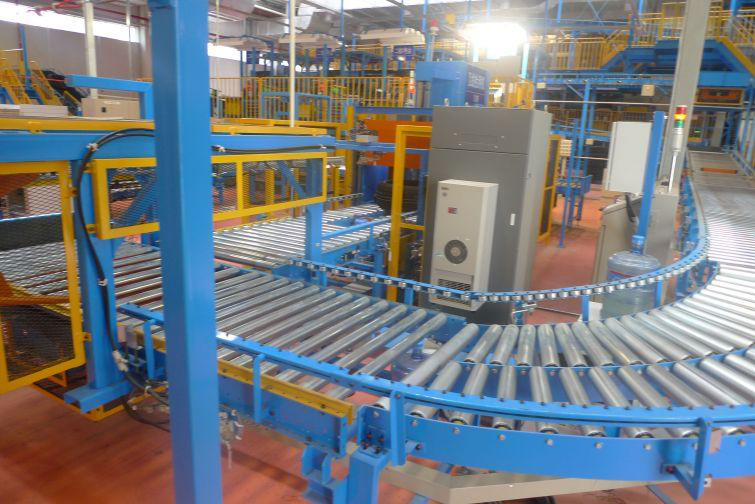
Roller conveyor (also known as roller conveyor or roller conveyor), it is a continuous conveying machinery, mainly used to complete the conveying of finished items, and has a long application history in modern production.
In the second half of the twentieth century, all walks of life have developed by leaps and bounds, and the degree of production mechanization and automation is also constantly improving, especially the general use of continuous production lines, which has injected new vitality into the wide application and development of roller conveyors. In the transportation of finished goods, the roller conveyor is the most commonly used conveying machinery, which is not only simple in structure, convenient in maintenance, but also flexible in layout, reliable in operation, and less equipment investment than other conveyors for finished goods.
At the same time, it can be used alone or in conjunction with other conveying machinery systems, so it has a wide range of applications and is highly adaptable. In the past two decades, due to the boom of home appliances and other industries, various production lines and assembly lines composed of roller conveyors have come into being. Therefore, roller conveyors are widely used in the production lines of machinery manufacturing, automobile manufacturing, home appliance manufacturing, food and beverage industry, and post and telecommunications departments to complete various process operations such as processing, assembly and testing, packaging, storage and transportation, and sorting. Due to the application of new technologies and new materials, as well as the ingenious use of various supporting auxiliary mechanisms, the function of the roller conveyor has been greatly extended and developed.

The operating characteristics of modern roller conveyors are as follows:
1) It has a variety of conveying properties, such as straight line conveying, right-angle transfer, curved conveying, and relying on gravity conveyance.
2) 2) The height difference due to the process and equipment requirements can be supplemented by borrowing the lifting platform, so that the production line can be connected as a whole; It is also possible to use a hoist to connect the production lines on different floors into one, so as to form a three-dimensional production line.
3) 3) During the operation, the workpiece can be paused in a controlled manner to facilitate the completion of the processing of a certain process or wait for the next process, and at the same time, it can also be stored and released at a fixed distance.
4) It can be rotated horizontally or reversed on the roller conveyor to correct the workpiece required by a certain process.
The development of roller conveyors in China and the compilation of standards are later than those of industrially developed countries. Before the eighties of the twentieth century, the roller conveyor was only used on a large scale in the mechanized assembly line in the production and processing workshop (such as casting, steel rolling, engine assembly, etc.), but most of the roller conveyors used were mainly special or non-standard equipment, and were far from forming the mass production and manufacturing of general products. By the mid-eighties of the last century, China's industry has developed by leaps and bounds, especially the rise and drive of some emerging industries (such as automobiles, home appliances, etc.), which began to adopt a large number of mechanized and automated assembly lines, and gradually popularized in other industries. Roller conveyors have also been widely used, so they have shown vigorous vitality, and their manufacturing scale and level have also entered a new stage.
It is mainly manifested in the following aspects:
1) The application range of roller conveyor continues to expand, and it has almost spread to the assembly line of various industries.
2) The application scale of the roller conveyor is gradually expanding, and the range of its conveying length is expanding in the assembly line system, the conveying speed can be from below 0lm/s to several meters per second, the weight of the transported goods can be from hundreds of grams to more than ten tons, and the shape and width of the items can also reach several meters.
3) Gradually form the specialized production of roller conveyors, at present, there are many roller conveyor manufacturers in China, which can produce general roller conveyors with complete specifications and varieties
4) The production technology level and manufacturing quality of the roller conveyor have been greatly improved.
5) In the standardization, generalization, serialization of roller conveyors have done a lot of useful basic work, China's roller conveyor industry standard in November 1991 declared the project, in January 1992 officially included in the Ministry of Mechanical and Electrical Machinery Industry Standard System, Revision Plan, completed in early 1993. The new roller conveyor is a new type of roller conveyor developed according to the basic theory of three-phase AC linear motor. The new roller conveyor is mainly used to transport heavy objects such as strips and blocks, and it is a kind of transportation equipment that doubles as a traction mechanism and a bearing mechanism with an idler. Roller conveyors are widely used in the metallurgical industry in hot continuous rolling and hot continuous casting billets, rolled steel pipes, steel plates and profiles, etc., in the building materials industry in flat glass, wood and plates, in the logistics industry airport baggage transportation line, and in the machinery industry engine, gearbox, reducer and motorcycle and other mechanical equipment assembly lines. The research and application of raceway (roller) conveyor and the development and application of linear induction motor have been reported in the literature. Among them, the literature on the specific application of linear induction motors in conveyors has also been reported. The relevant reports are as follows: Design and application of arc power roller conveyor, types and selection of roller conveyors, telescopic roller conveyors, turntable roller conveyors, multi-channel right-angle turning roller conveyors, linear motor driven plate conveyors, direct-drive belt conveyors, etc.